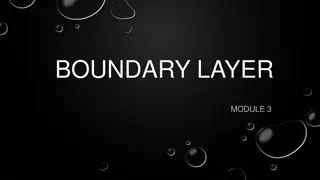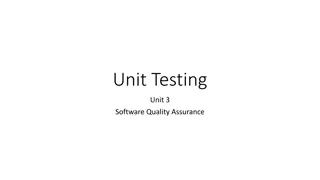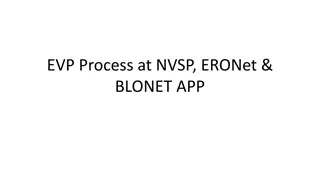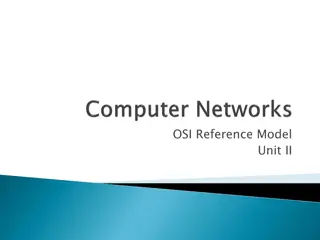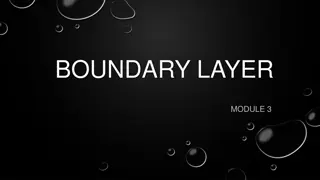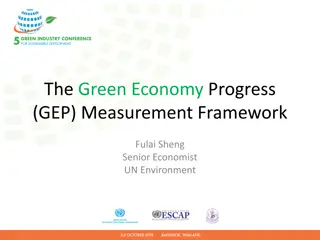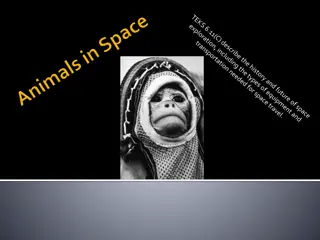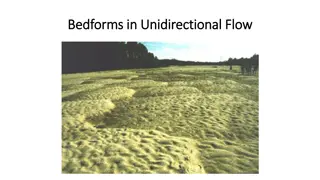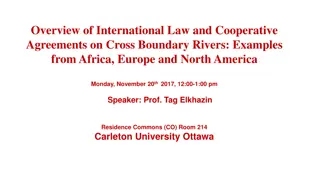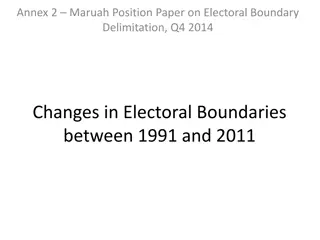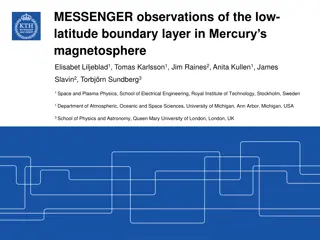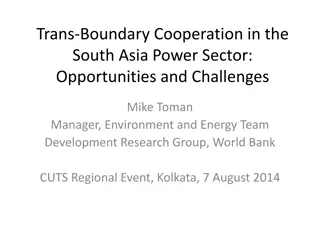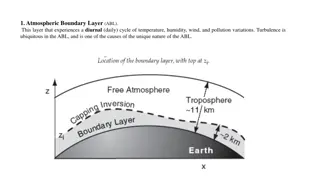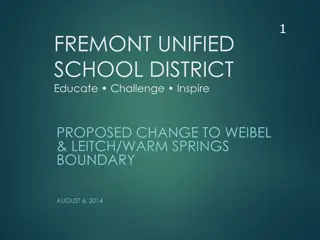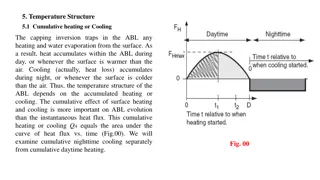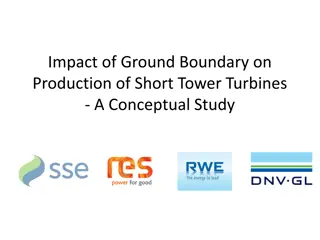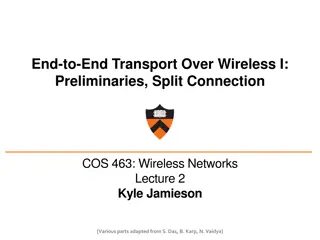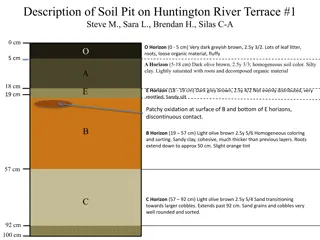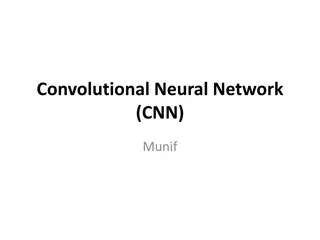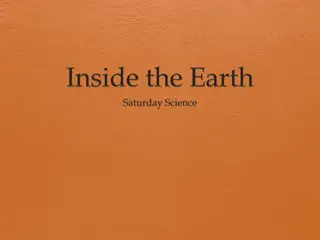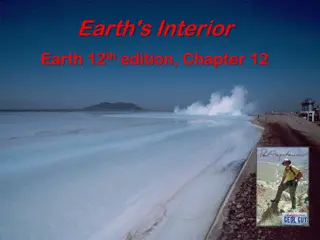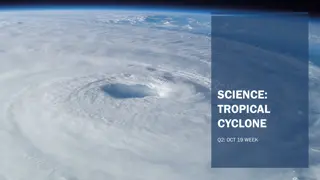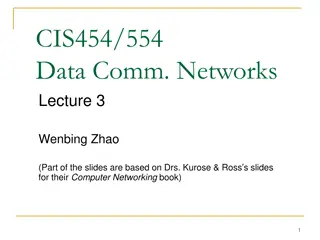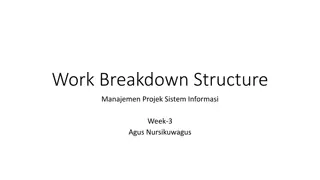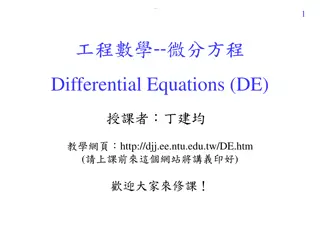Understanding Reflection and Transmission of Plane Waves in Electromagnetic Fields
The notes discuss the reflection and transmission of plane waves, wave vectors, fundamental polarizations (TMz and TEz), and boundary conditions at material interfaces. It covers the behavior of different types of plane waves, their interactions, and the conditions that govern their propagation thro
7 views • 57 slides
Understanding Linear Discrimination for Classification
Linear discrimination is a method for classifying data where examples from one class are separable from others. It involves using linear models or high-order functions like quadratic to map inputs to class separable spaces. This approach can be further categorized as class-based or boundary-based, e
3 views • 37 slides
Understanding Boundary Layers in Fluid Dynamics
A boundary layer forms when a fluid flows over a solid surface, with viscous forces present close to the surface. It can be laminar or turbulent, determined by the Reynolds number. Flow separation occurs in adverse pressure gradients, affecting lift and causing drag. Efforts to delay separation incl
1 views • 19 slides
Software Quality Assurance: Understanding Unit Testing and Boundary Value Testing
Unit testing is a crucial method in software development to ensure each part of the program behaves as intended. It helps detect problems early and provides a written contract for code quality. Additionally, Boundary Value Testing is a black box technique that focuses on input domain testing, with a
1 views • 49 slides
Understanding Communication Layers in Computer Networks
Communication in computer networks is facilitated through different layers such as the data link, network, and transport layers. Each layer has specific responsibilities in ensuring data delivery from one point to another. The data link layer handles communication between adjacent nodes, the network
3 views • 7 slides
Comprehensive Guide to Online Voter Registration Process at NVSP, ERONet & BLONET App
Navigate through the step-by-step process of online voter registration at NVSP, ERONet & BLONET App. Learn how to verify self-details, check family grouping, handle shifted/dead electors, assist unenrolled citizens, and engage with prospective electors. Explore boundary mapping techniques for creati
0 views • 32 slides
Understanding OSI Reference Model Layers
The OSI (Open Systems Interconnection) model consists of 7 layers, each with specific functions in network communication. From the Application layer handling user services to the Physical layer dealing with data transmission, learn about the responsibilities and interactions of these layers in netwo
0 views • 26 slides
Understanding OSI Model and TCP/IP Protocol Suite in Computer Networking
This chapter explores the OSI model and TCP/IP protocol suite, delving into protocol layers, addressing mechanisms, and network components. It highlights the interface between layers, functions of each layer in the OSI model, and compares TCP/IP protocol suite layers with OSI model layers. The discu
0 views • 30 slides
Understanding Boundary Layer and Drag Forces in Fluid Dynamics
Boundary layer module explains the presence of viscous forces near a surface due to fluid flow, leading to laminar or turbulent boundary layers. Flow separation occurs when a boundary layer detaches from a surface, impacting lift and drag forces. Adverse pressure gradients and flow separation phenom
0 views • 19 slides
Understanding CMOS Layers and Interconnect Design in Semiconductor Manufacturing
This content provides detailed insights into the CMOS layers, n-well process, p-well process, twin-tub process, metal interconnect layers, gate design, and layout strategies involved in semiconductor manufacturing. Explore the images and descriptions to grasp the complexities of MOS arrays, gate con
0 views • 27 slides
The Green Economy Progress Measurement Framework Overview
The Green Economy Progress (GEP) Measurement Framework, spearheaded by Fulai Sheng, a Senior Economist at UN Environment, emphasizes an Inclusive Green Economy (IGE) as a tool for sustainable development. It addresses poverty, inequitable prosperity sharing, and planetary boundary concerns by integr
0 views • 6 slides
Exploring Space: Pioneers, Missions, and the Role of Animals
Humans have a rich history of space exploration, with notable milestones including Yuri Gagarin's orbit in 1961, the Apollo 8 moon mission, and Sally Ride becoming the first American woman in space. Before human space travel, animals played a crucial role in understanding the effects of space on liv
4 views • 21 slides
Understanding the Layers of the Ionosphere
Explore the layers of the ionosphere including the D, E, Es, and F layers and how they impact radio wave propagation. Discover how solar activity affects ionization levels and skip distances, offering insights into long-distance communication potential. Learn about the influence of solar radiation o
0 views • 19 slides
Visualizing Relationships with Data: Earthquakes, Volcanoes, and Plate Tectonics
Explore the locations of earthquakes and volcanoes to understand plate boundary zones, compare plate motion in different regions, and determine plate boundary zones using various data sources. Follow step-by-step instructions to study maps, analyze earthquake and volcano distributions, and engage in
0 views • 37 slides
Exploring Animated Sprites in Computer Games Lecture #10
Delve into the exciting world of animated sprites with Lecture #10, covering boundary-checking procedures, animating sprites with multiple images, adding animation delays, and making sprites respond to multiple states. Learn about rotating, resizing, moving in different directions, calculating motio
1 views • 74 slides
Bedforms in Unidirectional Flow: Characteristics and Formation
Bedforms in unidirectional flow exhibit various characteristics such as sediment layer thicknesses, boundary layer dynamics, presence of ripples and dunes, and the interplay between flow velocity and sediment deposition. These bedforms, including ripples and dunes, form due to interactions between t
3 views • 13 slides
International Cooperation on Cross-Boundary Rivers: Perspectives from Around the Globe
Delve into the intricacies of international law and cooperative agreements concerning cross-boundary rivers, explored through examples from Africa, Europe, and North America. The discussion covers various legal frameworks, such as the Helsinki Rules, Berlin Rules, Vienna Convention, and more, highli
0 views • 15 slides
Changes in Singapore Electoral Boundary Delimitation from 1997 to 2011
Significant shifts in Singapore's electoral boundaries from 1997 to 2011 highlighted various changes such as GRC expansions, SMC formations, and boundary adjustments affecting multiple constituencies. Key alterations include mergers, splits, and transfers of constituencies to create new electoral la
0 views • 5 slides
Insights into the Low-Latitude Boundary Layer in Mercury's Magnetosphere
Study focuses on the low-latitude boundary layer (LLBL) in Mercury's magnetosphere, analyzing magnetosphere and magnetosheath plasma characteristics such as reconnection rates, IMF/magnetic shear, and plasma beta. Results show anti-correlation between LLBL and non-LLBL regions, with different reconn
0 views • 11 slides
Trans-Boundary Cooperation in South Asia Power Sector
This presentation, given at a regional event in Kolkata, discusses the opportunities and challenges of trans-boundary cooperation in the South Asia power sector. It explores the benefits of regional power integration, the analytical approach taken, baseline scenarios, potential impacts of regional c
0 views • 17 slides
Understanding Atmospheric Boundary Layer and Static Stability
The Atmospheric Boundary Layer (ABL) undergoes daily variations in temperature, humidity, wind, and pollution with turbulence being a key factor. Static stability in the environment determines the behavior of air parcels, leading to categorizations of stable, unstable, and neutral conditions based o
0 views • 13 slides
Proposed Boundary Change in Fremont Unified School District
Fremont Unified School District proposes a boundary change affecting Weibel, Leitch, and Warm Springs areas to address overcrowding. The change includes enrollment trends, growth projections, installation of temporary classrooms, and construction of permanent classrooms. The plan aims for board appr
0 views • 13 slides
Understanding Temperature Structure and Cumulative Heating/Cooling in Atmospheric Boundary Layer
The temperature structure in the atmospheric boundary layer (ABL) is influenced by cumulative heating or cooling effects from the surface. During the day, heat accumulates within the ABL, while cooling occurs at night. The cumulative heating or cooling is more crucial for ABL evolution than instanta
0 views • 12 slides
Understanding the Planetary Boundary Layer in Atmospheric Science
The Planetary Boundary Layer (PBL) plays a crucial role in atmospheric dynamics, divided into surface, mixed, stable, and residual layers. During the day, the mixed layer experiences convective motions due to surface heating, while the stable layer dominates during the night. Understanding these lay
0 views • 18 slides
Mastering Motion Guide Layers for Advanced Animation
Dive into the world of Motion Guide Layers to control object movement in animation projects. Learn how to create, use, and manipulate Motion Guide Layers effectively, along with tips on leveraging mask layers for spotlight effects and transitions. Discover techniques for grouping objects and creatin
0 views • 16 slides
Exploring the Impact of Cross-Boundary Primary Education Programs
Through a survey encompassing students from various European countries, it was found that participation in cross-boundary primary education initiatives led to increased motivation in learning school subjects like Physics and Physical Education. The projects also helped in enhancing English language
0 views • 15 slides
Ground Boundary Impact on Short Tower Turbines: A Conceptual Study
This conceptual study explores the impact of ground boundary on the production of short tower turbines. It investigates whether two turbines with the same rotor diameter but different hub heights can generate the same energy output. The study examines how the ground boundary influences the airflow p
0 views • 8 slides
Understanding Layering in Wireless Networks
This content delves into the concept of layering in wireless networks, highlighting the motivation behind layering, the Internet's approach to avoiding reimplementation for each underlying medium, the role of intermediate layers in providing abstractions, properties of network layers, and the functi
0 views • 53 slides
Detailed Descriptions of Soil Pits on Huntington River Terrace
The soil pits on Huntington River Terrace provide detailed insights into the soil composition at different depths. Terrace #1 exhibits dark greyish-brown to light olive-brown layers with varying textures, while Terrace #2 showcases well-sorted clay and gravel transitions. Terrace #3 presents a mixtu
0 views • 4 slides
Understanding Convolutional Neural Networks (CNN) in Depth
CNN, a type of neural network, comprises convolutional, subsampling, and fully connected layers achieving state-of-the-art results in tasks like handwritten digit recognition. CNN is specialized for image input data but can be tricky to train with large-scale datasets due to the complexity of replic
0 views • 22 slides
Understanding OSI Model and TCP/IP Protocol Suite in Computer Networking
This content delves into the OSI model and TCP/IP protocol suite, highlighting the protocol layers, addressing mechanisms, and communication scenarios. It explores the functions of each layer, the interface between layers, and compares the TCP/IP layers with the OSI model. Through examples and illus
0 views • 46 slides
Computational Earth Science: Solving Heat Flow in Objects with Complex Shapes Using Finite Difference Method
Explore projects involving the Finite Difference Method for solving static heat conduction problems, also known as the Poisson Equation. Topics include testing boundary conditions, symmetry of solutions, point sources, dipoles, and more. Gain insights into changing boundary conditions and understand
0 views • 20 slides
Journey to the Earth's Layers
The Earth's structure consists of four main layers: the crust, mantle, outer core, and inner core. The crust is the thin, rocky layer we see on the surface, while the mantle is a solid layer that flows like a viscous liquid. The outer core is a hot, melted layer of iron and nickel, and the inner cor
0 views • 10 slides
Journey to the Center of the Earth: Unveiling the Layers
Delve into the depths of the Earth with Dr. A.V. Tejankar to explore the three main layers - Crust, Mantle, and Core. Discover how the Earth's composition and physical properties vary across these layers, resembling the layers of an egg. Uncover the secrets of the Earth's interior, from the thin but
0 views • 15 slides
Exploring Earth's Interior: Layers, Structure, and Seismic Waves
Explore the dynamic layers of Earth's interior, from its three major layers formed by gravity and chemical segregation to mineral and phase changes in the mantle. Discover how seismic waves provide insights into the planet's composition as they interact with different layers, reflecting and refracti
0 views • 50 slides
Understanding Tropical Cyclones and Layers of the Atmosphere
Tropical cyclones are warm-core low-pressure systems that form over oceans with high sea surface temperatures. The Philippines is prone to these cyclones, leading to heavy rains, flooding, and strong winds. The layers of the atmosphere, from the exosphere to the troposphere, play crucial roles in sh
0 views • 7 slides
Understanding Protocol Layers in Computer Networking
Explore the concept of protocol layers in computer networks for organizing the structure of complex systems. Learn about the organization of network functionality similar to air travel processes and the benefits of layering in dealing with complex systems. Delve into the Internet Protocol Stack, hig
0 views • 29 slides
Cemetery GPS Inventory & Telecommunications Tower Location Project
Digitizing the Tower Addition section of the historic San Marcos City Cemetery and identifying an optimal location for a new telecommunications tower. The project involves creating a digital inventory of grave sites and integrating the data into a cemetery management software system. Utilizing vario
0 views • 19 slides
Project Management for Canoe Trip to Boundary Waters
This project involves planning and organizing a canoe trip to Boundary Waters, including tasks such as arranging travel, getting equipment, planning meals, preparing a budget, and managing emergencies. The work breakdown structure and task durations with dependencies are outlined to ensure a smooth
0 views • 8 slides
Understanding Differential Equations and Boundary Value Problems
Explore the world of Differential Equations (DE) with a focus on Boundary Value Problems, guided by Dennis G. Zill and Michael R. Cullen. Dive into the realm of First Order and Higher Order DE, Partial DE, Laplace Transform, Fourier Series, and more. Unravel the complexities of DE through various se
0 views • 33 slides


